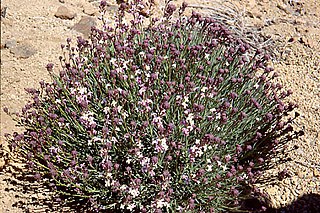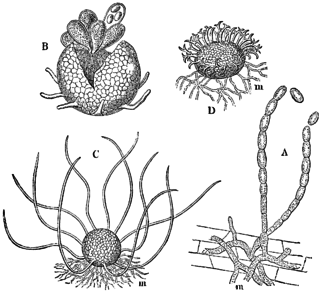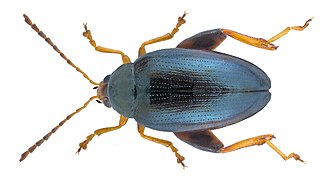
Brassicaceae or Cruciferae is a medium-sized and economically important family of flowering plants commonly known as the mustards, the crucifers, or the cabbage family. Most are herbaceous plants, while some are shrubs. The leaves are simple, lack stipules, and appear alternately on stems or in rosettes. The inflorescences are terminal and lack bracts. The flowers have four free sepals, four free alternating petals, two shorter free stamens and four longer free stamens. The fruit has seeds in rows, divided by a thin wall.

Erysimum, or wallflower, is a genus of flowering plants in the cabbage family, Brassicaceae. It includes more than 150 species, both popular garden plants and many wild forms. Erysimum is characterised by star-shaped and/or two-sided) trichomes growing from the stem, with yellow, red, pink or orange flowers and multiseeded seed pods.

Allium ursinum, known as wild garlic, ramsons, cowleekes, cows's leek, cowleek, buckrams, broad-leaved garlic, wood garlic, bear leek, Eurasian wild garlic or bear's garlic, is a bulbous perennial flowering plant in the amaryllis family Amaryllidaceae. It is native to Europe and Asia, where it grows in moist woodland. It is a wild relative of onion and garlic, all belonging to the same genus, Allium. There are two recognized subspecies: A. ursinum subsp. ursinum and A. ursinum subsp. ucrainicum.

Alliaria petiolata, or garlic mustard, is a biennial flowering plant in the mustard family (Brassicaceae). It is native to Europe, western and central Asia, north-western Africa, Morocco, Iberia and the British Isles, north to northern Scandinavia, and east to northern Pakistan and Xinjiang in western China.

Pieris, the whites or garden whites, is a widespread now almost cosmopolitan genus of butterflies of the family Pieridae. The highest species diversity is in the Palearctic, with a higher diversity in Europe and eastern North America than the similar and closely related Pontia. The females of many Pieris butterflies are UV reflecting, while the male wings are strongly UV absorbing due to pigments in the scales.

Pieris oleracea, or more commonly known as the mustard white, is a butterfly in the family Pieridae native to a large part of Canada and the northeastern United States. The nearly all-white butterfly is often found in wooded areas or open plains. There are two seasonal forms, which make it distinct from other similar species. Because of climate change, populations are moving further north.

Pieris virginiensis, the West Virginia white, is a butterfly found in North America in the Great Lakes states, along the Appalachians from New England to Alabama, and in southern Ontario. They are typically found in moist deciduous forests. Forestry, development, and a highly-invasive species that it confuses with its host plant (Cardamine) are causing this species to decline.

The mustard plant is any one of several plant species in the genera Brassica, Rhamphospermum and Sinapis in the family Brassicaceae. Mustard seed is used as a spice. Grinding and mixing the seeds with water, vinegar, or other liquids creates the yellow condiment known as prepared mustard. The seeds can also be pressed to make mustard oil, and the edible leaves can be eaten as mustard greens. Many vegetables are cultivated varieties of mustard plants; domestication may have begun 6,000 years ago.

The American toad is a common species of toad found throughout Canada and the eastern United States. It is divided into three subspecies: the eastern American toad, the dwarf American toad and the rare Hudson Bay toad. Recent taxonomic treatments place this species in the genus Anaxyrus instead of Bufo.

Cardamine diphylla is a flowering plant in the family Brassicaceae. It is a spring flowering woodland plant that is native to eastern North America.

Erysiphe cruciferarum is a plant pathogen of the family Erysiphaceae, which causes the main powdery mildew of crucifers, including on Brassica crops, such as cauliflower, cabbage, broccoli, and Brussels sprouts. E. cruciferarum is distributed worldwide, and is of particular concentration in continental Europe and the Indian subcontinent. E. cruciferarum is an ascomycete fungus that has both sexual and asexual stages. It is also an obligate parasite that appears to have host specificity; for example, isolates from turnip will not infect Brussels sprout, and vice versa. While being a part of the family Erysiphaceae, it belongs to those members in which the conidia are formed singly and whose haustoria are multilobed.
Many species of wildflowers are native to New England. There are four important community types which show considerable diversity and blending across this United States physiographic region. These are: alpine, coniferous forests, northern hardwood forests, and wetlands. Wetlands may be further subdivided into bogs, swamps, and bottomlands. This article lists some of these Wildflowers of New England and references sites for further research.

The leek moth or onion leaf miner is a species of moth of family Acrolepiidae and the genus Acrolepiopsis. The species is native to Europe and Siberia, but is also found in North America, where it is an invasive species. While it was initially recorded in Hawaii, this was actually a misidentification of Acrolepiopsis sapporensis.

Chorispora tenella is a species of flowering plant in the mustard family known by several common names, including purple mustard, blue mustard, musk mustard, and crossflower. This mustard is native to parts of Eurasia but is well known in other parts of the world, particularly in temperate regions, as an introduced species and a noxious weed.

Diplotaxis tenuifolia is a species of flowering plant in the mustard family known by the common name perennial wall-rocket. It is native to Europe and western Asia, where it grows on disturbed ground and roadsides, and it can now be found throughout much of the temperate world where it has naturalized. In recent years it has increasingly been cultivated to produce salad leaves, which are marketed as wild rocket in Britain or arugula in the US. It is easily confused with garden rocket, which has similar uses.

Phragmites australis, known as the common reed, is a species of flowering plant in the grass family Poaceae. It is a wetland grass that can grow up to 20 feet tall and has a cosmopolitan distribution worldwide.

Psylliodes chrysocephala or Psylliodes chrysocephalus, commonly known as the cabbage-stem flea beetle, is a species of leaf beetle situated in the subfamily Galerucinae and the tribe Alticini.

Garlic mustard was introduced to North America as a culinary herb in the 1860s and it is considered an invasive species in much of North America. As of 2020 it has been documented in most of the Eastern United States and Canada, with scattered populations in the west. It is listed as a noxious or restricted plant in the following states: Alabama, Connecticut, Massachusetts, Minnesota, New Hampshire, Oregon, Vermont, and Washington. A current map of its distribution in the United States can be found at the Early Detection and Distribution Mapping System (EDDmapS).

Ceutorhynchus obstrictus, the cabbage seedpod weevil, is a species of snout beetles or true weevils which is widespread in Europe and lives on several types of crucifers. The adult weevils feed on the leaves, but breed in the seedpods, where the larvae destroy the seeds. It can be a harmful pest on crops like rapeseed/canola, cabbage and relatives or Brassica rapa.

Ceutorhynchus constrictus is a species of minute seed weevil in the family Curculionidae. It is native to Europe, but has been released as a biological control agent for garlic mustard in North America.



















